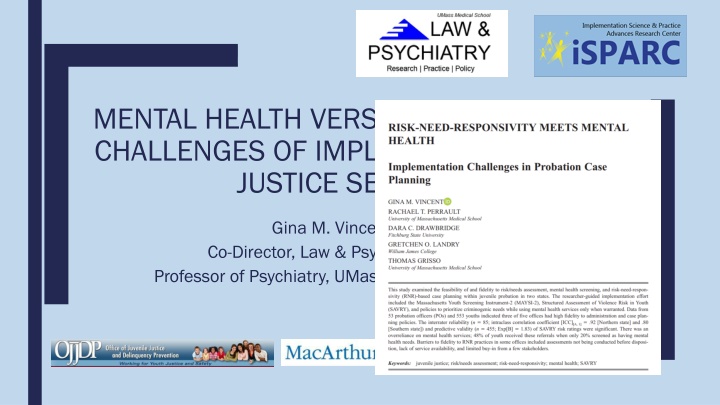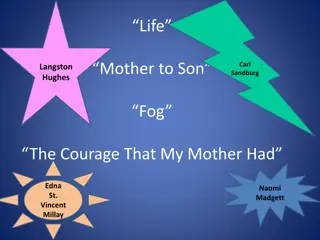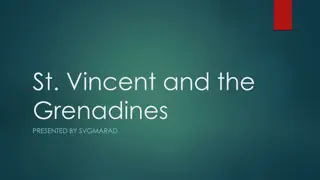
Challenges and Recommendations in Implementing RNR in Justice Settings
Explore the challenges of implementing Risk-Need-Responsivity (RNR) principles in justice settings and discover recommendations for reform to prevent youth reoffending. Learn about the importance of structured risk assessments, matching interventions with risk levels, and the principles of RNR. Gain insights from lessons in implementation science emphasizing the need for purposeful support to drive successful adoption of new practices over 2 to 4 years.
Download Presentation

Please find below an Image/Link to download the presentation.
The content on the website is provided AS IS for your information and personal use only. It may not be sold, licensed, or shared on other websites without obtaining consent from the author. If you encounter any issues during the download, it is possible that the publisher has removed the file from their server.
You are allowed to download the files provided on this website for personal or commercial use, subject to the condition that they are used lawfully. All files are the property of their respective owners.
The content on the website is provided AS IS for your information and personal use only. It may not be sold, licensed, or shared on other websites without obtaining consent from the author.
E N D
Presentation Transcript
https://www.umassmed.edu/contentassets/7baa47a9690f440c9335363bcea7854d/isparc-email-version-100px.pnghttps://www.umassmed.edu/contentassets/7baa47a9690f440c9335363bcea7854d/isparc-email-version-100px.png MENTAL HEALTH VERSUS DYNAMIC RISK: CHALLENGES OF IMPLEMENTING RNR IN JUSTICE SETTINGS Gina M. Vincent, PhD Co-Director, Law & Psychiatry Program Professor of Psychiatry, UMass Chan Medical School MacFound
Recommendations For Reform & Preventing Youth Reoffending National Research Council of the National Academy of National Research Council of the National Academy of Sciences (2013). Sciences (2013). Use structured risk and need assessment instruments to identify low-risk youths who can be handled less formally in community-based settings, to match youths with specialized treatment, and to target more intensive and expensive interventions toward high-risk youths. Risk Risk- -Need Need- -Responsivity Responsivity
Risk and Needs Assessment Instruments for Youth 1. Who do I need to be most concerned about? 2. What should I do about it? Ohio Youth Assessment System
Risk Assessment Must be Paired With Practices that Risk Assessment Must be Paired With Practices that Promote Risk Promote Risk- -Needs Needs- -Responsivity (RNR) Responsivity (RNR) Risk Principle Match the intensity of the intervention with one s level of risk for re-offending Need Principle Target dynamic or changeable risk factors and only those factors (criminogenic needs) Responsivity Principle Match the mode & strategies of services with the individual The "How" The "Who" The "What" vb How to do it How to do it How much to do & How much to do & with whom with whom What to do What to do
Lessons from Implementation Science It requires about 2 to 4 full years fully operational and have an impact on the recipient of services (e.g., Barrett, Bradshaw, & Lewis-Palmer, 2008; Fixsen et al., 2005) 2 to 4 full years for adoption of a new practice to become Training is necessary, but alone is insufficient. It increases knowledge but, in isolation, it does nothing to change practice. Decades of evidence from studies in human service areas shows that only about 5-15% of attempts to use new innovations (or EBPs) will succeed in the absence of purposeful implementation supports. Active Implementation Frameworks Fixsen, Blas , & Van Dyke (2019)
Implementation of Need Principle Implementation of Need Principle % of Youth With Need That Actually Received a Service (n = 148) 100% Need present Need addressed 80% 60% 40% 20% 0% Peterson-Badali, Skilling, Haqanee (2014)
RISK ASSESSMENT AND BEHAVIORAL hEALTH SCREENING (RABS) STUDY PURPOSE: PURPOSE: To test a comprehensive approach to implementation of RNR principles in youth justice to prioritize dynamic risk while still attending to mental health when indicated MacFound
Risk Assessment and Behavioral health Screening (RABS) Study Mixed-methods feasibility and fidelity study following a comprehensive, 1-year implementation process in 2 states: SAVRY risk assessment MAYSI-2 behavioral health screening Research Questions: Research Questions: 1. Were JPOs able to complete the SAVRY with fidelity (IRR and PV)? 2. Did JPOs adhere to instrument administration policies? (policy fidelity) 3. Did JPOs adhere to RNR-principles in their case planning? (procedural fidelity) *Also interviewed JPOs to assess feasibility
RABS Implementation Procedures What was implemented? What was implemented? Training in RNR & Case Planning Service Matrix Policies & Procedures for Administration Integration into Electronic System RNR-Based case plans Disposition recs template RNR-related Policies for Use in Disposition Recommendations & Case Planning Implementation Process Implementation Process Staff Training on SAVRY & MAYSI-2 Case plan aligned
Training: Responsivity Principle & Mental Health Training: Responsivity Principle & Mental Health Mental Health is not a risk factor it does not increase the likelihood that someone will reoffend - but . Among youth - mental health problems are related to higher levels of dynamic risk/need domains (Guebert & Olver, 2014; McCormick et al., 2017; Schubert et al., 2011) o o Treatment of dynamic risk factors/needs has a larger impact on reoffending than MH-related programming (McCormick et al., 2017; Skeem et al., 2011) but . Matching services to both dynamic risk/need domains and mental health needs can result in lower reoffending rates within key domains (e.g., personality/behavior, education/employment) (McCormick et al., 2017) o o Message to JPOs: Message to JPOs: Case plans should incorporate MH treatment when MH may underlie the risk factors or interfere with risk reduction services but it should not be in lieu of risk reduction services.
Risk Assessment and Behavioral health Screening (RABS) Study Sample: Sample: All Youth eligible for the SAVRY (risk assessment) and MAYSI-2 (mental health screen) over 9 months (N = 856) Juvenile Probation Officers (JPOs; N = 54) interviewed at 4.5 months Youth case management data were tracked M = 10 mths (min 6 mths)
Could JPOs Complete the SAVRY To Fidelity? Could JPOs Complete the SAVRY To Fidelity? South (N = 67) .80*** Inter Inter- -Rater Reliability Rater Reliability (ICC (ICCA, 1 A, 1) ) NE NE Predictive Validity over 602 days Predictive Validity over 602 days (N = 18) .92*** 100% Summary Risk Rating (Risk Summary Risk Rating (Risk Level) Level) Disruptive Behavior Disruptive Behavior Problems Problems Attitudes/Orientation Attitudes/Orientation Low (n=194) Moderate (n=188) High (n=73) 90% 80% .77*** .80*** 70% 60% .88*** .77*** 50% Emotional Stability Emotional Stability .89*** .78*** 40% p < .001 30% Family Family .59 .57** p < .01 20% 10% Education Education .81*** .70*** 0% Negative Peers Negative Peers Substance Abuse Substance Abuse .50 .82*** .80*** Any petition n = 97 Violent petition n = 38 .85*** Cox Regressions: Cox Regressions: Any petition - Exp(B) = 1.83*** Violent petitions - Exp(B) = 1.96** ICC .75 = excellent; .60 ICC < .75 = good
Did They Adhere to Instrument Administration Policies? Did They Adhere to Instrument Administration Policies? Only 55.6% (n = 461) of youth had a MAYSI-2 Only 53.9% had a SAVRY SAVRY Risk Levels (n= 477) 100% 90% Site Site- -Level Differences in Adherence Level Differences in Adherence High in NE state & 2 Southern offices > 90% 80% 70% 60% 50% 41% 41% Moderate in one Southern office = 67% 40% 30% 18% 20% Poor in one Southern office = 23% 10% 0% Risk Level Low Risk n=42 Moderate Risk n=75 20.4% were Critical MAYSI-2 cases High Risk n=33
Did They Adhere to RNR Did They Adhere to RNR- -Based Case Planning Policies? Based Case Planning Policies? Types of Service Referrals ( Types of Service Referrals (n n = 437 youth w/assessments) = 437 youth w/assessments) 100% 90% 80% 70% 60% 47.50% 50% 40% 24.50% 30% 23.40% 22.90% 22.00% 18.80% 14.70% 20% 10% 0% Disruptive Behavior Substance Use Family Education Peer Relations Attitude Orientation Emotional Stability 142 of the 437 received no service referrals
Did They Adhere to RNR Policy Regarding Types of Did They Adhere to RNR Policy Regarding Types of Service Referrals Service Referrals - - Responsivity? Responsivity? Types of Service Referrals for Youth by MAYSI-2 Critical Case Status (n = 437) 100% Not Critical on MAYSI Critical on MAYSI2 80% 52% 60% 49% 38% 36% 40% 27% 27% 27% 26% 26% 26% 23% 21% 19% 19% 16% 13% 20% 0% Mental Health Disruptive Behavior Substance Abuse Family Education Peer Attitude MH and Risk Reduction
One Southern County One Southern County - - Service % of Youth Rated High in Need That Received a Service % of Youth Rated High in Need That Received a Service Service- -to to- -Need Match: Need Match: 100 What Was Different? What Was Different? 84.9 80 73.3 68.8 1. Strong supervisors who provided coaching & QA 60 53.7 48.3 46.2 36.7 40 2. Strong judge buy in 20 3. Well resourced in terms of services 0
Conclusions Conclusions 1. Were JPOs able to complete the SAVRY with fidelity? YES 2. Did JPOs adhere to instrument administration policies? DEPENDS Administered SAVRY & MAYSI to most youth in all but 2 offices However, NE state never accomplished this pre-disposition as per policy 3. Did JPOs adhere to the need and responsivity principles? Mostly NO MH the most common referral (> 50% of youth) regardless of MH screen indicating only 20% may need it Most of these youth also received a dynamic risk-related service One site implemented the principles very well!
Conclusions Conclusions What interfered with implementation & does not work? (JPO interviews) Post-disposition assessments (NE state) simply did not work systemic obstacles Stakeholder buy-in problems w/seasoned JPOs and one judge (the site with poorest adherence) Service availability limited in rural areas MH referrals the go-to Buy-in from MH providers was low in many sites & is essential (Haqanee et al., 2014) Data management system problems What DOES work? Strong supervision with coaching & quality assurance Strong judge, provider, & JPO buy-in Well-resourced with services
Conclusions Conclusions Limitations: Limitations: Just the first year of implementation agencies generally approve and achieve outcomes later MAYSI-2 is a screen; shouldn t drive treatment decisions, BUT ..way more youth received MH services than screened in & it should be the opposite Recommendations: Recommendations: All clinicians & providers should be educated system s risk/needs assessment defines dynamic risks (criminogenic needs) MH providers should educate JPOs about how they can or cannot address these risks should be educated about RNR & how the justice
Recommendations cont. Recommendations cont. How Forensic Clinicians/Clinicians Might Facilitate Use of RNR With Fidelity? In evaluations, clearly align treatment recommendations with dynamic risk areas/criminogenic needs Assess the severity Assess the severity of a mental health condition & whether it is a targeted responsivity factor, barrier, or neither (not severe) Inform the PO developing a case plan Collectively, ensure both mental health (when ensure both mental health (when applicable) and dynamic risks applicable) and dynamic risks are addressed in plans






















